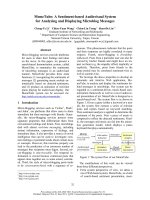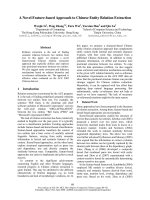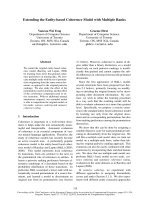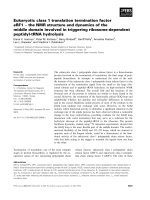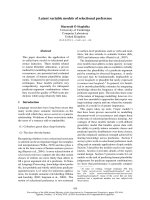Báo cáo khoa học: "Latent Class Transliteration based on Source Language Origin" doc
Bạn đang xem bản rút gọn của tài liệu. Xem và tải ngay bản đầy đủ của tài liệu tại đây (347.84 KB, 5 trang )
Proceedings of the 49th Annual Meeting of the Association for Computational Linguistics:shortpapers, pages 53–57,
Portland, Oregon, June 19-24, 2011.
c
2011 Association for Computational Linguistics
Latent Class Transliteration based on Source Language Origin
Masato Hagiwara
Rakuten Institute of Technology, New York
215 Park Avenue South, New York, NY
Satoshi Sekine
Rakuten Institute of Technology, New York
215 Park Avenue South, New York, NY
Abstract
Transliteration, a rich source of proper noun
spelling variations, is usually recognized by
phonetic- or spelling-based models. How-
ever, a single model cannot deal with dif-
ferent words from different language origins,
e.g., “get” in “piaget” and “target.” Li et
al. (2007) propose a method which explicitly
models and classifies the source language ori-
gins and switches transliteration models ac-
cordingly. This model, however, requires an
explicitly tagged training set with language
origins. We propose a novel method which
models language origins as latent classes. The
parameters are learned from a set of translit-
erated word pairs via the EM algorithm. The
experimental results of the transliteration task
of Western names to Japanese show that the
proposed model can achieve higher accuracy
compared to the conventional models without
latent classes.
1 Introduction
Transliteration (e.g., “バラクオバマ baraku obama /
Barak Obama”) is phonetic translation between lan-
guages with different writing systems. Words are
often transliterated when imported into differet lan-
guages, which is a major cause of spelling variations
of proper nouns in Japanese and many other lan-
guages. Accurate transliteration is also the key to
robust machine translation systems.
Phonetic-based rewriting models (Knight and
Jonathan, 1998) and spelling-based supervised mod-
els (Brill and Moore, 2000) have been proposed for
recognizing word-to-word transliteration correspon-
dence. These methods usually learn a single model
given a training set. However, single models cannot
deal with words from multiple language origins. For
example, the “get” parts in “piaget / ピアジェ piaje”
(French origin) and “target / ターゲット t
¯
agetto”
(English origin) may differ in how they are translit-
erated depending on their origins.
Li et al. (2007) tackled this issue by proposing a
class transliteration model, which explicitly models
and classifies origins such as language and genders,
and switches corresponding transliteration model.
This method requires training sets of transliterated
word pairs with language origin. However, it is diffi-
cult to obtain such tagged data, especially for proper
nouns, a rich source of transliterated words. In ad-
dition, the explicitly tagged language origins are not
necessarily helpful for loanwords. For example, the
word “spaghetti” (Italian origin) can also be found
in an English dictionary, but applying an English
model can lead to unwanted results.
In this paper, we propose a latent class transliter-
ation model, which models the source language ori-
gin as unobservable latent classes and applies appro-
priate transliteration models to given transliteration
pairs. The model parameters are learned via the EM
algorithm from training sets of transliterated pairs.
We expect that, for example, a latent class which is
mostly occupied by Italian words would be assigned
to “spaghetti / スパゲティsupageti” and the pair will
be correctly recognized.
In the evaluation experiments, we evaluated the
accuracy in estimating a corresponding Japanese
transliteration given an unknown foreign word,
53
s:
t:
i
i
Figure 1: Minimum edit operation sequence in the alpha-
beta model (Underlined letters are match operations)
using lists of Western names with mixed lan-
guages. The results showed that the proposed model
achieves higher accuracy than conventional models
without latent classes.
Related researches include Llitjos and Black
(2001), where it is shown that source language ori-
gins may improve the pronunciation of proper nouns
in text-to-speech systems. Another one by Ahmad
and Kondrak (2005) estimates character-based error
probabilities from query logs via the EM algorithm.
This model is less general than ours because it only
deals with character-based error probability.
2 Alpha-Beta Model
We adopted the alpha-beta model (Brill and Moore,
2000), which directly models the string substitu-
tion probabilities of transliterated pairs, as the base
model in this paper. This model is an extension to
the conventional edit distance, and gives probabil-
ities to general string substitutions in the form of
α → β (α, β are strings of any length). The whole
probability of rewriting word s with t is given by:
P
AB
(t|s) = max
T ∈Part(t),S∈Part(s)
|S|
i=1
P (α
i
→ β
i
), (1)
where Part(x) is all the possible partitions of word
x. Taking logarithm and regarding −log P(α → β)
as the substitution cost of α → β, this maximiza-
tion is equivalent to finding a minimum of total sub-
stitution costs, which can be solved by normal dy-
namic programming (DP). In practice, we condi-
tioned P (α → β) by the position of α in words,
i.e., at the beginning, in the middle, or at the end of
the word. This conditioning is simply omitted in the
equations in this paper.
The substitution probabilities P (α → β) are
learned from transliterated pairs. Firstly, we obtain
an edit operation sequence using the normal DP for
edit distance computation. In Figure 1 the sequence
is f→f, ε →u, l→r, e→e, ε →k, x→k, and so on.
Secondly, non-match operationsare merged with ad-
jacent edit operations, with the maximum length of
substitution pairs limited to W . When W = 2,
for example, the first non-match operation ε →u is
merged with one operation on the left and right, pro-
ducing f→fu and l→ur. Finally, substitution prob-
abilities are calculated as relative frequencies of all
substitution operations created in this way. Note that
the minimum edit operation sequence is not unique,
so we take the averaged frequencies of all the possi-
ble minimum sequences.
3 Class Transliteration Model
The alpha-beta model showed better performance in
tasks such as spelling correction (Brill and Moore,
2000), transliteration (Brill et al., 2001), and query
alteration (Hagiwara and Suzuki, 2009). However,
the substitution probabilities learned by this model
are simply the monolithic average of training set
statistics, and cannot be switched depending on the
source language origin of given pairs, as explained
in Section 1.
Li et al. (2007) pointed out that similar problems
arise in Chinese. Transliteration of Indo-European
names such as “亜歴山大 / Alexandra” can be ad-
dressed by Mandarin pronunciation (Pinyin) “Ya-Li-
Shan-Da,” while Japanese names such as “山本 /
Yamamoto” can only be addressed by considering
the Japanese pronunciation, not the Chinese pro-
nunciation “Shan-Ben.” Therefore, Li et al. took
into consideration two additional factors, i.e., source
language origin l and gender / first / last names g,
and proposed a model which linearly combines the
conditioned probabilities P (t|s, l, g) to obtain the
transliteration probability of s → t as:
P (t|s)
soft
=
l,g
P (t, l, g|s)
=
l,g
P (t|s, l, g)P (l, g|s) (2)
We call the factors c = (l, g) as classes in this paper.
This model can be interpreted as firstly computing
54
the class probability distribution given P(c|s) then
taking a weighted sum of P (t|s, c) with regard to
the estimated class c and the target t.
Note that this weighted sum can be regarded
as doing soft-clustering of the input s into classes
with probabilities. Alternatively, we can employ
hard-clustering by taking one class such that c
∗
=
arg max
l,g
P (l, g|s) and compute the transliteration
probability by:
P (t|s)
hard
∝ P (t|s, c
∗
). (3)
4 Latent Class Transliteration Model
The model explained in the previous section inte-
grates different transliteration models forwords with
different language origins, but it requires us to build
class detection model c from training pairs explicitly
tagged with language origins.
Instead of assigning an explicit class c to each
transliterated pair, we can introduce a random vari-
able z and consider a conditioned string substitution
probability P (α → β|z). This latent class z cor-
responds to the classes of transliterated pairs which
share the same transliteration characteristics, such as
language origins and genders. Although z is not di-
rectly observable from sets of transliterated words,
we can compute it via EM algorithm so that it max-
imizes the training set likelihood as shown below.
Due to the space limitation, we only show the up-
date equations. X
train
is the training set consisting
of transliterated pairs {(s
n
, t
n
)|1 ≤ n ≤ N}, N is
the number of training pairs, and K is the number of
latent classes.
Parameters:
P (z = k) = π
k
, P (α → β|z)
(4)
E-Step: γ
nk
=
π
k
P (t
n
|s
n
, z = k)
K
k=1
π
k
P (t
n
|s
n
, z = k)
, (5)
P (t
n
|s
n
, z) = max
T ∈Part(t
n
),S∈Part(s
n
)
|S|
i=1
P (α
i
→ β
i
|z)
M-Step: π
∗
k
=
N
k
N
, N
k
=
N
n=1
γ
nk
(6)
P (α → β|z = k)
∗
=
1
N
k
N
n=1
γ
nk
f
n
(α → β)
α→β
f
n
(α → β)
Here, f
n
(α → β) is the frequency of substitution
pair α → β in the n-th transliterated pair, whose
calculation method is explained in Section 2. The
final transliteration probability is given by:
P
latent
(t|s) =
z
P (t, z|s) =
z
P (z|s)P (t|s, z)
∝
z
π
k
P (s|z)P (t|s, z) (7)
The proposed model cannot explicitly model
P (s|z), which is in practice approximated by
P (t|s, z). Even omitting this factor only has a
marginal effect on the performance (within 1.1%).
5 Experiments
Here we evaluate the performance of the transliter-
ation models as an information retrieval task, where
the model ranks target t
for a given source s
, based
on the model P (t
|s
). We used all the t
n
in the
test set X
test
= {(s
n
, t
n
)|1 ≤ n ≤ M} as target
candidates and s
n
for queries. Five-fold cross vali-
dation was adopted when learning the models, that
is, the datasets described in the next subsections are
equally splitted into five folds, of which four were
used for training and one for testing. The mean re-
ciprocal rank (MRR) of top 10 ranked candidates
was used as a performance measure.
5.1 Experimental Settings
Dataset 1: Western Person Name List This
dataset contains 6,717 Western person names and
their Katakana readings taken from an European
name website 欧羅巴人名録
1
, consisting of Ger-
man (de), English (en), and French (fr) person name
pairs. The numbers of pairs for these languages are
2,470, 2,492, and 1,747, respectively. Accent marks
for non-English languages were left untouched. Up-
percase was normalized to lowercase.
Dataset 2: Western Proper Noun List This
dataset contains 11,323 proper nouns and their
Japanese counterparts extracted from Wikipedia in-
terwiki. The languages and numbers of pairs con-
tained are: German (de): 2,003, English (en): 5,530,
Spanish (es): 781, French (fr): 1,918, Italian (it):
1
/>55
Language de en fr
Precision(%) 80.4 77.1 74.7
Table 1: Language Class Detection Result (Dataset 1)
1,091. Linked English and Japanese titles are ex-
tracted, unless the Japanese title contains any other
characters than Katakana, hyphen, or middle dot.
The language origin of titles were detected
whether appropriate country names are included in
the first sentence of Japanese articles. If they con-
tain “ドイツの (of Germany),” “フランスの (of
France),” “イタリアの (of Italy),” they are marked
as German, French, and Italian origin, respectively.
If the sentence contains any of Spain, Argentina,
Mexico, Peru, or Chile plus “の”(of), it is marked
as Spanish origin. If they contain any of Amer-
ica, England, Australia or Canada plus “の”(of), it
is marked as English origin. The latter parts of
Japanese/foreign titles starting from “,” or “(” were
removed. Japanese and foreign titles were split into
chunks by middle dots and “ ”, respectively, and re-
sulting chunks were aligned. Titles pairs with differ-
ent numbers of chunks, or ones with foreign char-
acter length less than 3 were excluded. All accent
marks were normalized (German “ß” was converted
to “ss”).
Implementation Details P(c|s) of the class
transliteration model was calculated by a charac-
ter 3-gram language model with Witten-Bell dis-
counting. Japanese Katakanas were all converted
to Hepburn-style Roman characters, with minor
changes so as to incorporate foreign pronunciations
such as “wi / ウィ” and “we / ウェ.” The hyphens
“ー” were replaced by the previous vowels (e.g., “ス
パゲッティー” is converted to “supagettii.”)
The maximum length of substitution pairs W de-
scribed in Section 2 was set W = 2. The EM al-
gorithm parameters P (α → β|z) were initialized to
the probability P (α → β) of the alpha-beta model
plus Gaussian noise, and π
k
were uniformly initial-
ized to 1/K. Based on the preliminary results, we
repeated EM iterations for 40 times.
5.2 Results
Language Class Detection We firstly show the
precision of language detection using the class
Language de en es fr it
Precision(%) 65.4 83.3 48.2 57.7 66.1
Table 2: Language Class Detection Result (Dataset 2)
Model Dataset 1 Dataset 2
AB 94.8 90.9
HARD 90.3 89.8
SOFT 95.7 92.4
LATENT 95.8 92.4
Table 3: Model Performance Comparison (MRR; %)
transliteration model P (c|s) and Equation (3) (Table
5.2, 5.2). The overall precision is relatively lower
than, e.g., Li et al. (2007), which is attributed to the
fact that European names can be quite ambiguous
(e.g., “Charles” can read “チャールズ ch
¯
aruzu” or
“シャルル sharuru”) The precision of Dataset 2 is
even worse because it has more classes. We can also
use the result of the latent class transliteration for
clustering by regarding k
∗
= arg max
k
γ
nk
as the
class of the pair. The resulting cluster purity way
was 0.74.
Transliteration Model Comparison We show
the evaluation results of transliteration candidate re-
trieval task using each of P
AB
(t|s) (AB), P
hard
(t|s)
(HARD), P
soft
(t|s) (SOFT), and P
latent
(t|s) (LA-
TENT) (Table 5.2). The number of latent classes
was K = 3 for Dataset 1 and K = 5 for Dataset 2,
which are the same as the numbers of language ori-
gins. LATENT shows comparable performance ver-
sus SOFT, although it can be higher depending on
the value of K, as stated below. HARD, on the other
hand, shows lower performance, which is mainly
due to the low precision of class detection. The de-
tection errors are alleviated in SOFT by considering
the weighted sum of transliteration probabilities.
We also conducted the evaluation based on the
top-1 accuracy of transliteration candidates. Be-
cause we found out that the tendency of the results
is the same as MRR, we simply omitted the result in
this paper.
The simplest model AB incorrectly reads “Felix
/ フェリックス,” “Read / リード” as “フィリス
Firisu” and “レアード Re
¯
ado.” This may be because
English pronunciation “x / ックス kkusu” and “ea /
56
イー
¯
i” are influenced by other languages. SOFT
and LATENT can find correct candidates for these
pairs. Irregular pronunciation pairs such as “Caen
/ カーン k
¯
an” (French; misread “シャーン sh
¯
an”)
and “Laemmle / レムリ Remuri” (English; misread
“リアム Riamu”) were misread by SOFT but not by
LATENT. For more irregular cases such as “Hilda/
イルダ Iruda”(English), it is difficult to find correct
counterparts even by LATENT.
Finally, we investigated the effect of the number
of latent classes K. The performance is higher when
K is slightly smaller than the number of language
origins in the dataset (e.g., K = 4 for Dataset 2) but
the performance gets unstable for larger values of K
due to the EM algorithm initial values.
6 Conclusion
In this paper, we proposed a latent class translitera-
tion method which models source language origins
as latent classes. The model parameters are learned
from sets of transliterated words with different ori-
gins via the EM algorithm. The experimental re-
sult of Western person / proper name transliteration
task shows that, even though the proposed model
does not rely on explicit language origins, itachieves
higher accuracy versus conventional methods using
explicit language origins. Considering sources other
than Western languages as well as targets other than
Japanese is the future work.
References
Farooq Ahmad and Grzegorz Kondrak. 2005. Learning a
spelling error model from search query logs. In Proc.
of EMNLP-2005, pages 955–962.
Eric Brill and Robert C. Moore. 2000. An improved
error model for noisy channel spelling. In Proc. ACL-
2000, pages 286–293.
Eric Brill, Gary Kacmarcik, and Chris Brockett. 2001.
Automatically harvesting katakana-english term pairs
from search engine query logs. In Proc. NLPRS-2001,
pages 393–399.
Masato Hagiwara and Hisami Suzuki. 2009. Japanese
query alteration based on semantic similarity. In Proc.
of NAACL-2009, page 191.
Kevin Knight and Graehl Jonathan. 1998. Machine
transliteration. Computational Linguistics, 24:599–
612.
Haizhou Li, Khe Chai Sum, Jin-Shea Kuo, and Minghui
Dong. 2007. Semantic transliteration of personal
names. In Proc. of ACL 2007, pages 120–127.
Ariadna Font Llitjos and Alan W. Black. 2001. Knowl-
edge of language origin improves pronunciation accu-
racy. In Proc. of Eurospeech, pages 1919–1922.
57
